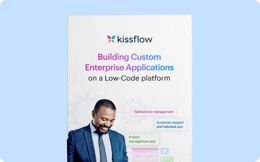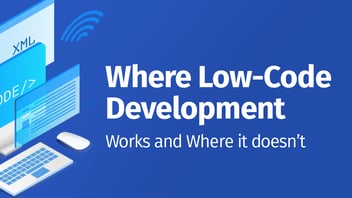
- >
- Low-Code Platform>
- Low-Code Overview
Low-Code Technology - An Ultimate Guide to Low-Code Development
Team Kissflow
Updated on 11 Jul 2025 • 13 min read
The low-code revolution: Building apps without code
Low-code is a software development approach that requires little to no coding to build applications and processes. Instead of using complex programming languages, you can employ visual interfaces with basic logic and drag-and-drop capabilities in a low-code development platform. As they are a quick and simple alternative to conventional software development, these platforms have grown in popularity.
Low-Code is transforming the way enterprises develop applications by eliminating complexities and accelerating delivery times. According to Gartner's latest forecast, the global low-code market is projected to reach $65 billion by 2027 and $187 billion by 2030, growing at a CAGR of 31.1 percent between 2020 and 2030. This rapid adoption confirms what we've seen across our 10,000+ customers: low-code transforms how businesses approach software development.
As organizations face growing IT backlogs and the need for rapid innovation, Low-Code development has emerged as the perfect solution to build scalable, efficient, and user-friendly applications. With its visual development approach, drag-and-drop interfaces, and prebuilt templates, Low-Code empowers businesses to bridge the gap between technical and non-technical teams, fostering seamless collaboration. In this guide, we’ll dive deep into the fundamentals of Low-Code, explore its benefits, and discuss how it’s shaping the future of software development.

Building Custom Enterprise Applications on a Low-Code Platform
Thank you for downloading!
What is low-code development?
Low-Code development refers to a software development methodology that leverages minimal hand-coding, allowing users to create applications visually. It is designed to accelerate the development process, enabling faster time-to-market for enterprise apps.
Low-code empowers developers with a flexible and visual environment to develop simple to complex applications in a graphical interface. With advanced tools like drag-and-drop modelers, pre-built templates, intuitive UI, etc., low-code technology allows developers to design and deploy apps much faster, allowing organizations to scale, be more profitable, and achieve above-average returns.
"Low-code and no-code tools are a way to mitigate talent shortages because they allow companies to build systems without the need for large teams of developers"
- Amitha Pulijala, Forrester
Vice president of product, cloud platform services, CX, API, and AI at Vonage.
Low-code creation frameworks allow IT customers to incorporate building blocks into workflows and apps. These essential elements abstract the code behind actions and orders, allowing IT to create interfaces and business applications without coding them by hand.
Key features of low-code development
1. Visual modeling tools
Low-code platforms let users build apps with visual tools, making it easier for business users and developers to understand and participate in the development process. At Kissflow, our customers typically see an 80 percent reduction in development time when using our visual process modeler compared to traditional development.

2. Out-of-the-box functionality
|
Feature |
Traditional Development |
Kissflow Low-Code |
|
Form Builder |
8-16 hours coding |
15-30 minutes |
|
User Access Controls |
Custom coding required |
Built-in role management |
|
Reporting Dashboard |
Custom development |
Pre-built templates |
|
Mobile Responsiveness |
Additional development |
Automatic |
| Feature | Traditional Development | Kissflow Low-Code |
|---|---|---|
|
Form Builder
|
8-16 hours coding |
15-30 minutes |
|
User Access Controls
|
Custom coding required |
Built-in role management |
|
Reporting Dashboard
|
Custom development |
Pre-built templates |
|
Mobile Responsiveness
|
Additional development |
Automatic |
3. Drag-and-drop interface
Our internal testing shows that even first-time users can create a simple approval workflow in under 10 minutes using our drag-and-drop interface.
4. Enterprise-grade security
Security is built into the platform, with advanced features like:
Multi-factor authentication
Role-based access control
Data encryption at rest and in transit
Comprehensive audit logging
SOC 2 Type II compliance
5. Scalability for growing businesses
Kissflow's low-code platform seamlessly scales from teams of 10 to organizations with 10,000+ users, with performance maintained even under heavy loads.
To dive deeper into automation within low-code platforms, explore this in-depth guide on Power Automate.
Low-code vs. traditional development: A comparison
|
Aspect |
Traditional development |
Low-code development |
|
Time to Market |
3-6 months |
2-4 weeks |
|
Technical Expertise Required |
High (coding skills) |
Low to Medium |
|
Cost |
$50,000+ |
$5,000-$25,000 |
|
Maintenance |
Regular developer intervention |
Minimal technical support |
|
Flexibility |
Highly customizable |
Pre-built components with customization options |
|
Learning Curve |
Steep |
Gentle |
| Aspect | Traditional Development | Low-code development |
|---|---|---|
|
Time to Market
|
3-6 months |
2-4 weeks |
|
Technical Expertise Required
|
High (Coding skills) |
Low to Medium |
|
Cost
|
$50,000+ |
$5,000-$25,000 |
|
Maintenance
|
Regular developer intervention |
Minimal techical support |
|
Flexibility
|
Highly customizable |
Pre-built components with customization options |
|
Learning Curve
|
Steep |
Gentle |
Benefits of low-code for enterprises
Low-code platforms provide enterprise businesses with a powerful means to enhance productivity, streamline app development, and reduce costs, all while maintaining simplicity and agility. From mitigating the risks of shadow IT to facilitating faster app deployment, these platforms are essential for helping enterprises tackle IT backlogs and accelerate digital transformation initiatives.
Selecting the best low-code platform for your specific business requirements is crucial to maximize these benefits and ensure successful implementation across your organization
1. Increased productivity
Low-code platforms empower business users to create their applications, reducing dependence on IT. As a result, productivity increases because teams can quickly implement their ideas without waiting for developer support. By shortening the gap between concept and execution, low-code platforms enable businesses to innovate more rapidly and efficiently.
2. Cost savings
Low-code development significantly reduces the need for highly specialized developers. It cuts down development timelines, saving both time and money. For example, what might take several months with traditional development methods can be done in a fraction of the time using low-code, leading to substantial cost savings when scaled across multiple applications.
3. Mitigates shadow IT
Low-code platforms help mitigate the risk of shadow IT by providing a secure environment where business users can create applications that comply with internal IT standards. Employees often turn to unapproved third-party apps without such platforms, introducing security risks. A low-code platform ensures compliance and reduces the risk of data breaches by offering a governed, internal solution.
4. Faster app development
Traditional app development can take months or even longer, but low-code platforms accelerate the process dramatically. Both experienced developers and non-technical users can quickly build applications using pre-built components and drag-and-drop functionality. This results in fewer bugs, quicker launches, and more agile operations.
5. Easy maintenance
Low-code platforms simplify maintenance using pre-tested, modular components that integrate seamlessly, leading to fewer bugs and smoother updates. Any changes or upgrades can be implemented without causing disruptions to existing functionalities, allowing businesses to stay agile and up-to-date with minimal effort.
Additional benefits for business leaders
Prevents technical debt
By providing a structured and standardized environment for application development, low-code platforms help prevent technical debt. This reduces the risk of inefficient coding practices and ensures that applications are built to scale and are easy to maintain in the long term.
Improved decision-making
Low-code platforms offer integration capabilities that provide access to real-time data and insights, allowing business leaders to make data-driven decisions that can improve overall performance.
Access to new technologies
Low-code platforms facilitate the integration of emerging technologies like AI and machine learning into business applications, allowing enterprises to stay competitive and up-to-date without needing extensive coding or development resources, helping businesses modernize their processes quickly and efficiently.
Who are the low-code developers?
Low-code platforms are versatile tools that cater to a wide range of users, from business teams to IT professionals. Among the key users are IT leaders and directors, who leverage low-code platforms to accelerate application development, reduce backlogs, and enhance operational efficiency.
IT leaders
Solving IT backlogs
IT leaders often face a significant backlog of internal applications and development projects. Low-code tools solve this by enabling faster application development with pre-built templates, drag-and-drop interfaces, and modular components. These features allow IT departments to quickly tackle pending projects, reduce bottlenecks, and ensure the timely deployment of business-critical applications. IT leaders can free up valuable resources and focus on more strategic initiatives by streamlining the development process.
Enhancing team productivity
Low-code platforms enable IT leaders to delegate specific development tasks to non-technical team members. IT teams can focus on more complex, high-priority tasks by empowering business users to build and modify their applications, Improving overall team productivity, and fostering greater collaboration between IT and business departments. With the reduced reliance on specialized developers, IT leaders can accelerate process automation and optimize workflows across the organization.
IT directors
Improving operational efficiency
For IT directors, low-code tools are essential for improving operational efficiency. These platforms simplify the development and deployment of applications, allowing IT teams to automate repetitive tasks, streamline workflows, and enhance overall system performance. Low-code tools also offer better collaboration within IT departments, enabling team members to work more efficiently and respond faster to business needs. This results in more agile and responsive IT operations that can scale with the organization's growth.
Low-code application platform (LCAP)
A Low-Code Application Platform (LCAP) enables IT directors to efficiently manage and deploy applications. LCAPs centralize the development, testing, and deployment process, minimizing the need for extensive coding. By using an LCAP, you reduce development time, lower costs, and simplify the management of large-scale applications. LCAPs also ensure compliance by providing strong governance and security features while maintaining operational agility.
If you're evaluating different development approaches based on user roles and complexity, this low-code vs no-code comparison will help you decide which platform best suits your needs.
Discover the top low-code platforms transforming the way teams build applications
View list
Getting started with low-code: 5 simple steps

1. Define the processes and data
The underlying element of any application is processing data. Start by defining the processes that align with business needs to get a structured flow. This helps create apps so that the processes are in the right order, and it is easier to achieve the result.
You can also find the most effective path by implementing process simulation and deriving new insights. Once you have a set of defined processes, collecting the right and necessary data becomes more effortless.. Determine the data required to carry out the processes seamlessly from start to end.
2. Create user-friendly forms
Low-code adoption becomes easier if the user experience is seamless and good. Based on the defined process and data, and with drag-and-drop features, intuitive forms can be created to collect relevant information. A robust low-code system enables users to build forms dynamically with user-based control and ready-to-use widgets. Creating the perfect form with any field type and functionality helps build apps better.
3. Build a fully functional application
Many business process management (BPM) companies have increasingly started adopting low-code solutions due to their novel approach, which emphasizes minimal coding requirements. You can also modify the default code to unlock more advanced features in the app. One of the most significant advantages of a low-code platform is business-process automation.
With pre-built templates and visual development features, you can automate repetitive tasks that do not require human intervention. This saves employees' time and effort, which can be better put into business-critical tasks.
4. Execute and test the application
Testing the application is a mandatory step before launching it. This way, any sort of technical issues and glitches can be identified before the application goes live. A faulty application can adversely affect the efficiency and performance of processes.
Low-code systems also provide a testing environment where the built application can be scrutinized and tested multiple times to check its performance and eliminate technical faults. Based on the test results and user feedback, necessary changes can be made before the app is pushed to the live stage.
5. Deploy the application
Low-code offers flexible application deployment. You can install, configure, and set up fully functional applications with just a few clicks. Along with the deployment, low-code systems also provide real-time feature updates, fixes, and updates.
Overcoming low-code adoption challenges
Although low-code can offer many benefits, there are also some challenges that organizations should be aware of when implementing this approach.
One of the main challenges of low-code technology is that it can be difficult for non-technical users to understand and navigate the platform. This can make it difficult for business analysts and domain experts to create and test their own apps, and make it harder for IT departments to support and maintain those apps.
Another challenge is that low-code solutions can be limiting when it comes to customization and scalability. While the drag-and-drop interface can be intuitive and easy to use, it may not offer the same level of flexibility as traditional coding methods. Creating complex or custom apps that meet an organization's specific needs can be challenging.
What can you build using low-code development?
As organizations exponentially grow, they tend to adopt new technologies to ensure operational efficiency. Low-code is one such robust technology that enables organizations to be digitally progressive. With low-code functionality, you can create flexible solutions such as automating processes, digitizing your operations, managing requests, and building custom applications at speed and scale.
Use cases for low-code development:

Low-Code is versatile and can be applied across various industries and scenarios:
Some other examples of low-code development
Employee lifecycle management
Purchase management
Expense claim management
Complaint management
Marketing budget management
Sales lead management
IT bug tracking management
IT incident management
Future of Low code
As competition increases, finding the best low-code platform that aligns with your organization's technical requirements and business goals will become increasingly important for successful digital transformation initiatives.
Market Size and Growth:
The global low-code development platform market is estimated at $21.17 billion in 2025 and is projected to reach $81.35 billion by 2030, growing at a compound annual growth rate (CAGR) of 30.9 percent during this period
Adoption Rate:
By 2025, low-code platforms are expected to account for over 70 percent of all application development activity, up from just 20 percent[1] in 2020. Gartner further predicts that by 2026, 75 percent[2] of new application development will use low-code tools.
Citizen Developers:
The democratization of software development is accelerating: by 2026, 80 percent[3] of users of low-code development tools will be outside traditional IT departments, reflecting the mainstream rise of "citizen developers"-business professionals without formal programming training who build apps using these platforms. In 2025, about 70 percent[4] of new apps are expected to be built using low-code or no-code platforms.
Learning Curve:
70 percent[5] of low-code users with no prior experience were able to learn the platform within one month or less, making these tools highly accessible and accelerating adoption within organizations.
Enterprise Adoption:
66 percent[6] of organizations plan to increase their low-code development efforts, and larger enterprises are increasingly adopting these platforms to streamline processes and reduce reliance on IT departments.
Application Demand:
According to Microsoft, over 500 million new applications will need to be built over the next few years, more than all the apps developed in the last 40 years combined, driving further demand for low-code solutions.
Technology Integration:
Low-code platforms increasingly integrate advanced technologies like AI, machine learning, IoT, and blockchain, enabling even non-technical users to build complex, intelligent applications.
Kissflow Low-Code Platform Pricing: Scalable Plans That Fit Your Enterprise
Our Pricing Plans
Why Kissflow is built for enterprise low-code
Kissflow is a unified low-code/no-code platform that bridges the gap between business users and IT to simplify work management and dramatically accelerate digital transformation. Business users can take control of their digital needs while IT leaders can continue providing a secure and scalable platform for digital growth.
Get started with Kissflow Platform and learn how to leverage its features to drive better results
Kissflow platform can help your business:
- Automate, customize, and streamline processes from start to end.
- Digitize operations across departments and branches
- Manage requests from multiple teams
- Build holistic, custom applications that fit your needs
- Facilitate cross-departmental collaboration
Kissflow combines low-code flexibility with enterprise-grade capabilities:
Visual Development:
Create powerful applications with our intuitive interface
Pre-built Templates:
Get started quickly with 50+ industry-specific templates
Integration Hub:
Connect with 1000+ applications through our API connectors
Governance Center:
Maintain compliance with centralized controls
Enterprise Security:
Protect sensitive data with advanced security features
How our customers use low-code

Case study: SoftBank telecom transforms approval processes
SoftBank Telecom transformed its manual, email-based processes with Kissflow's low-code platform, achieving remarkable results:
Built new apps in just 30 minutes
Enabled 10-20 mobile approvals/day
Cut training time to 10 mins
Removed costly tool licenses
Scaled across US, UK, and Germany

Case study: Puma Energy powers remote collaboration
Puma Energy, a global downstream retailer in the Oil and Gas industry, leveraged Kissflow to transform its paper-based processes during COVID-19:
Grew from 200 to 1,500 users 1 year
Automated 40+ key business processes
Empowered teams to build their own apps
Digital Key Operations
Switched to self-serve Supplier portal
Customer success metrics
70 percent reduction
in application development time
85 percent of applications
built by business users without IT support
60 percent decrease
in IT backlog within 6 months
ROI achieved
within 4.5 months on average
Discover how Kissflow can help your organization meet digital demands without adding complexity. Whether you're tackling a backlog, launching new tools, or scaling existing processes, low-code with Kissflow helps you move faster and build smarter.
Start your low-code journey with kissflow.
Get Started
Frequently Asked Questions
Choose a platform that holds certifications like SOC 2, ISO 27001, HIPAA, GDPR, and CCPA. Review the platform’s encryption methods for data at rest and in transit. Ensure role-based access controls, audit logging, and robust vulnerability management practices are in place. Kissflow offers enterprise-grade security features and complete documentation on these topics.
Confirm that the platform supports your specific regulatory needs, including data residency options and the ability to make region-specific deployments. Kissflow provides compliance attestations to support industries governed by strict regulations such as healthcare, finance, and government.
Kissflow provides pre-built connectors for leading enterprise systems like Salesforce, SAP, and Microsoft services. Our platform supports REST, SOAP, and GraphQL APIs to connect securely to custom and legacy systems. Reference cases are available upon request.
Yes. Kissflow offers flexible integration frameworks and robust database connectors. We support middleware solutions when needed to bridge gaps between legacy and modern systems.
Kissflow is designed to handle large deployments across multiple geographies. We share performance benchmarks and architectural documentation upon request. Our platform supports dynamic scaling based on user load, data volume, and transaction complexity.
Kissflow supports automatic scaling, performance tuning, load balancing, and caching mechanisms to maintain consistent performance under peak demand.
Kissflow offers a centralized administration console, version control, role-based permissions, approval workflows, and citizen development governance frameworks. Our governance module ensures adherence to enterprise standards without stifling innovation.
Kissflow supports the full application lifecycle—development, testing, staging, and production. Integrated DevOps pipelines, rollback options, and environment management are built into the platform.
TCO includes licensing (based on user volume or app complexity), infrastructure, training, integration, support, and expansion needs. A 3-5 year TCO analysis often shows significant savings compared to traditional development, both in time and cost.
Kissflow maintains transparent pricing. Consider potential add-ons such as additional storage, custom integrations, API call volumes, or expanded user licenses. Pricing history is stable, and details are openly shared.
Top low-code platforms offer visual development environments with drag-and-drop interfaces and pre-built components. The best ones provide robust database management, API integration capabilities, and responsive UI design tools. Enterprise-grade solutions include application lifecycle management features, team collaboration tools, and deployment options across multiple environments while maintaining the development speed advantages of low-code.
Low-code dramatically accelerates development through visual tools and pre-built components, while traditional programming offers unlimited flexibility through hand-written code. Low-code platforms handle infrastructure complexity automatically, while traditional approaches require more technical expertise. Low-code development is more accessible to business users, creating citizen developers, while traditional coding remains the domain of professional developers. The speed advantage of low-code comes with some customization limitations that traditional programming doesn't face.
Mid-sized businesses gain the most from low-code, balancing sophisticated needs with limited IT resources. Regulated industries like finance and healthcare benefit from governance features while maintaining development speed. Professional services firms create client-facing portals and internal tools without lengthy development cycles. Organizations with rapidly changing requirements appreciate the agility to modify applications quickly as needs evolve.
Organizations with frequent process changes benefit most from low-code's rapid development capabilities. Companies with limited IT resources can empower business users to create applications. Enterprises needing to modernize legacy systems appreciate low-code's integration capabilities. Organizations with diverse business needs value the ability to quickly create purpose-built applications rather than forcing processes into one-size-fits-all solutions.
Technical limitations arise when requirements exceed platform capabilities, requiring workarounds. Integration with legacy systems often requires custom code that breaks the low-code paradigm. Governance becomes complex as more citizen developers create applications without IT oversight. Performance optimization is more constrained than with traditional development. Perhaps most significantly, organizations may face vendor lock-in due to the proprietary nature of low-code platforms.
Related Articles











